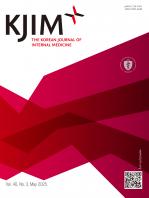|
Review
Omics-based biomarkers for diagnosis and prediction of kidney allograft rejection
Jeong-Hoon Lim, Byung Ha Chung, Sang-Ho Lee, Hee-Yeon Jung, Ji-Young Choi, Jang-Hee Cho, Sun-Hee Park, Yong-Lim Kim, Chan-Duck Kim
Korean J Intern Med. 2022;37(3):520-533. Published online April 15, 2022
Kidney transplantation is the preferred treatment for patients with end-stage kidney disease, because it prolongs survival and improves quality of life. Allograft biopsy is the gold standard for diagnosing allograft rejection. However, it is invasive and reactive, and continuous monitoring is unreal..
|
|
|
Nephrology / Original Article
Update of aristolochic acid nephropathy in Korea
Tae Hyun Ban, Ji-Won Min, Changhwan Seo, Da Rae Kim, Yu Ho Lee, Byung Ha Chung, Kyung-Hwan Jeong, Jae Wook Lee, Beom Seok Kim, Sang-Ho Lee, Bum Soon Choi, Jin Suk Han, Chul Woo Yang
Korean J Intern Med. 2018;33(5):961-969. Published online March 20, 2018
Background/Aims: The true incidence of aristolochic acid nephropathy (AAN) is thought to be underestimated because numerous ingredients known or suspected to contain aristolochic acid (AA) are used in traditional medicine in Korea.
Methods: We collected data on cases of AAN since 1996 via a databas..
|
|
|
Nephrology / Original Article
Effect of low-dose valsartan on proteinuria in normotensive immunoglobulin A nephropathy with minimal proteinuria: a randomized trial
Young-Il Jo, Ha-Young Na, Ju-Young Moon, Sang-Woong Han, Dong-Ho Yang, Sang-Ho Lee, Hyeong-Cheon Park, Hoon-Young Choi, So-Dug Lim, Jeong-Hae Kie, Yong-Kyu Lee, Sug-Kyun Shin
Korean J Intern Med. 2016;31(2):335-343. Published online February 15, 2016
Background/Aims: Immunoglobulin A nephropathy (IgAN) is a generally progressive disease, even in patients with favorable prognostic features. In this study, we aimed to investigate the antiproteinuric effect and tolerability of low-dose valsartan (an angiotensin II receptor blocker) therapy in normo..
|
|
|
















